Japan's Ministry of Economy, Trade and Industry (METI) has announced its shortlist of finalists for the 2007 Robot Award. The nominees include 9 robots in three categories (service robots, industrial robots, and public sector robots), as well as 4 robot-related items in the components/software category.
Here is a list of the robots by category (details for each robot are provided below):
Service robots
- MR Image-Guided Surgical Robotic System
- LEGO Mindstorms NXT
- HOAP
- miuro
- Robotic Blood Sample Courier System
Industrial robots
- M-430iA Robot Arms
- Pharmaceutical Container Replacement Robot
Public sector/frontier robots
- Endovascular Surgery Simulator - EVE
- Fire-Fighting Robot
Robot components/software
- HG1T/HG1H teaching pendant
- OpenRTM-aist-0.4.0 RT middleware
- Harmonic Drive Systems' mini AC servo actuators
- ORiN open network interface for robots/factory automation equipment
METI established the annual Robot Award last year to recognize outstanding developments in the field of robotics, to encourage further research and development, and to stimulate demand. The 2007 Robot of the Year will be selected from these nominees, and the results will be announced in late December.
- - - - - - - - - -
SERVICE ROBOTS
- MR Image-Guided Surgical Robotic System

Kyushu University
Hitachi, Ltd.
Hitachi Medical Corp.
MIZUHO Co., Ltd.
University of Tokyo
Waseda University
This endoscopic surgery support system uses a high-precision robotic surgical clamp that moves like a tiny (1-cm diameter) human hand, while magnetic resonance images (MRI) provide real-time navigation during surgery. Able to outperform the human hand and eye, this system brings an unprecedented level of accuracy and safety to endoscopic surgery. The system is still in the research and development phase, but its effectiveness has been confirmed in 8 liver cancer treatments performed between April and September 2007.
- - - - - - - - - -
- LEGO Mindstorms NXT
 The LEGO Group
The LEGO Group
The LEGO Mindstorms NXT kit includes programmable bricks with electric motors, sensors, and Lego Technic pieces (such as gears, axles, beams, and pneumatic parts), which can be used to construct robots. As a fun learning tool that helps students develop creativity and gain hands-on experience building robots, Mindstorms NXT stimulates interest in technology and improves communication and problem-solving skills. Over 1,000 educational institutions in Japan (25,000 worldwide) use Mindstorms NXT in the classroom, and over 100,000 children from 35 nations participate in LEGO robot competitions each year.
- - - - - - - - - -
- HOAP (Humanoid for Open Architecture Platform)
 Fujitsu
Fujitsu
Fujitsu Laboratories Limited
Fujitsu Automation Limited
The HOAP (Humanoid for Open Architecture Platform) series of mini-humanoid robots are used by researchers to develop new robot applications. The 60-cm tall HOAP is equipped with a microphone, camera, sensors for maintaining posture and position, and simulation software used to check operations programs beforehand. Full disclosure of hardware and software interface information makes HOAP a complete, open architecture robot enabling anyone to develop their own software algorithms. Since the first version of HOAP became commercially available in 2001, 129 units have been sold to an assortment of Japanese universities, research institutes and companies. HOAP's use as a research vehicle has helped accelerate the pace at which bipedal humanoid robots are being developed. [More]
- - - - - - - - - -
- miuro
 ZMP Inc.
ZMP Inc.
Miuro -- short for "Music Innovation based on Utility RObot technology" -- is a network audio robot that plays music from a docked iPod or from a wirelessly connected computer. Gyroscopes and acceleration sensors enable miuro to follow you from room to room and dance while blasting tunes through speakers developed by Kenwood. Miuro promises to help create a new market for devices that combine robotics and audio technology. To further develop the market, ZMP plans to begin selling a limited-edition model at the Apple Store in December 2007 and release a low-cost version next year.
- - - - - - - - - -
- Robotic Blood Sample Courier System

Matsushita Electric Works, Ltd.
Matsushita's Robotic Blood Sample Courier System consists of autonomous mobile robots working as a team to perform blood sample delivery and courier tasks at hospitals and laboratories. A group control computer assigns various tasks to individual robots who pick up blood samples, deliver them to automatic analyzers, and collect the samples after testing. An automatic battery charging system enables the system to work around the clock by preventing all the robots from running out of power at the same time. At present, 17 robot systems are working at hospitals and laboratories, where they are helping to improve the reliability and efficiency of operations. [More]
- - - - - - - - - -
INDUSTRIAL ROBOTS
- Food/pharmaceutical handling system with M-430iA robot arms and visual tracking

FANUC Ltd.
This robotic food and pharmaceutical handling system features a visual tracking system and a pair of multi-axis robot arms that each can accurately pick up 120 items per minute as they move along a conveyor belt. The arms can work non-stop 24 hours a day, are resistant to acid and alkaline cleaners, and feature wrists with plastic parts that eliminate the need for grease. The sanitary design provides the cleanliness required of machines tasked with handling food and medicine. With a proven record of success in reducing manufacturing costs and improving quality, about 150 systems have been sold to manufacturers worldwide since October 2006. [More]
- - - - - - - - - -
- Pharmaceutical Container Replacement Robot
 Tsumura & Co.
Tsumura & Co.
Fuji Heavy Industries, Ltd.
This autonomous robot is capable of navigating tight spaces at factories for the purpose of transporting containers used in the pharmaceutical manufacturing process. The robot can automatically connect itself to large containers (or cases packed with products) weighing up to 200 kilograms (440 lbs) for transport. The robot only needs to be charged once per day, it can be freely programmed and customized to suit the manufacturing process, and it is safe and easy to use on existing production lines. Three robots are now working on production lines at a pharmaceutical factory, where they have reportedly boosted productivity by 30%. More are scheduled to go online soon.
- - - - - - - - - -
PUBLIC SECTOR/FRONTIER ROBOTS
- Endovascular Surgery Simulator - EVE
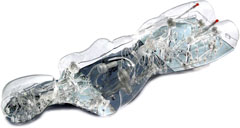 FAIN-Biomedical Inc.
FAIN-Biomedical Inc.
Nagoya University
EVE, the Endovascular Surgery Simulator, is a robot patient designed to help train physicians in the art of catheter surgery, a cutting-edge technique in the treatment of some vascular conditions. Built on technology developed at Nagoya University's Fukuda Lab, EVE uses computer scans to recreate a specific patient's blood vessels to an accuracy of 0.01 mm. Complete with a pulse and artificial blood circulating through the system, the robot patient provides a safe and realistic environment for training physicians in the use of catheters and other endovascular devices, while eliminating the need for animal tests. EVE also monitors the progress of mock operations and provides verbal and visual feedback to the surgeon. The simulator also provides catheter producers a convenient way to evaluate and exhibit their products. [More]
- - - - - - - - - -
- Fire-Fighting Robot
 Komatsu Ltd.
Komatsu Ltd.
IVIS, Inc.
I.DEN Videotronics
CyVerse Corp.
Maruma Technica Co., Ltd.
This remote-control fire-fighting robot goes where its human comrades cannot, and its relatively compact size makes it ideal for combating blazes in urban environments. An array of 8 high-resolution wide-angle cameras provides a panoramic view of the surroundings, and a multi-channel control system allows 10 fire-fighting robots to be deployed simultaneously. Special nozzles that are 10 times more powerful than those on conventional fire hoses allow the robot to blast flames with 5,000 liters of water per minute. The Tokyo Fire Department now has two robots on call, with more to be deployed in the future, as needed.
- - - - - - - - - -
ROBOT COMPONENTS/SOFTWARE
- The HG1T/HG1H teaching pendant by IDEC Corporation is a user-friendly tool for programming robots.
- The OpenRTM-aist-0.4.0 RT (robot technology) middleware, developed by the New Energy and Industrial Technology Development Organization (NEDO), the National Institute of Advanced Industrial Science and Technology (AIST) and the Japan Robot Association (JARA), is recognized for contributing to the development of an open robot architecture based on the modular construction of element robot technologies such as actuators, sensors and control programs.
- Mini AC servo actuators developed by Harmonic Drive Systems are recognized for their superior performance.
- ORiN software developed by Denso Wave, Inc. is recognized for contributing to the creation of an open network interface for robots and factory automation equipment.
[Source: Robot Award 2007]
 As Japan's dwindling ranks of farmers grow old, scientists are developing new ways to lighten their physical load and keep them productive. At the Tokyo University of Agriculture and Technology, a research team led by professor Shigeki Toyama has developed a wearable power-assist robot suit designed to boost the strength of farmers working in the field.
As Japan's dwindling ranks of farmers grow old, scientists are developing new ways to lighten their physical load and keep them productive. At the Tokyo University of Agriculture and Technology, a research team led by professor Shigeki Toyama has developed a wearable power-assist robot suit designed to boost the strength of farmers working in the field. 
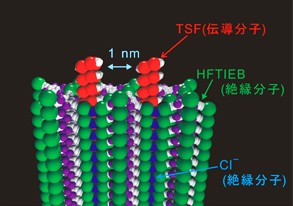 In a development that brings superdense memory devices and molecule-sized machines a step closer to reality, scientists at Japan's Institute of Physical and Chemical Research (
In a development that brings superdense memory devices and molecule-sized machines a step closer to reality, scientists at Japan's Institute of Physical and Chemical Research (
 ZMP Inc.
ZMP Inc.

 In an effort to accelerate the development of next-generation automobiles and robots, Toyota is turning to some of Japan's top neuroscientists. According to a December 14 announcement, the automaker has teamed up with the Institute of Physical and Chemical Research (
In an effort to accelerate the development of next-generation automobiles and robots, Toyota is turning to some of Japan's top neuroscientists. According to a December 14 announcement, the automaker has teamed up with the Institute of Physical and Chemical Research (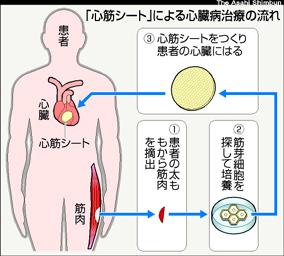 Medical researchers from Osaka University Hospital have succeeded in repairing the weakened heart of a severe cardiac patient by applying thin sheets of muscle tissue grown from cells taken from the patient's thigh. The regenerative medicine technique -- described as the world's first in which a patient waiting for an organ transplant was successfully treated using his or her own cells -- may one day provide an alternative to heart transplant, the researchers say.
Medical researchers from Osaka University Hospital have succeeded in repairing the weakened heart of a severe cardiac patient by applying thin sheets of muscle tissue grown from cells taken from the patient's thigh. The regenerative medicine technique -- described as the world's first in which a patient waiting for an organ transplant was successfully treated using his or her own cells -- may one day provide an alternative to heart transplant, the researchers say. 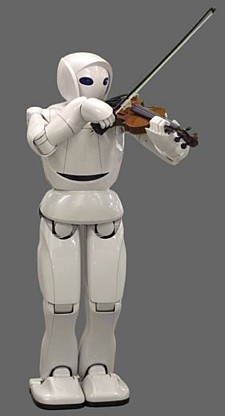 On December 6, several months after Toyota's DJ Robot
On December 6, several months after Toyota's DJ Robot 
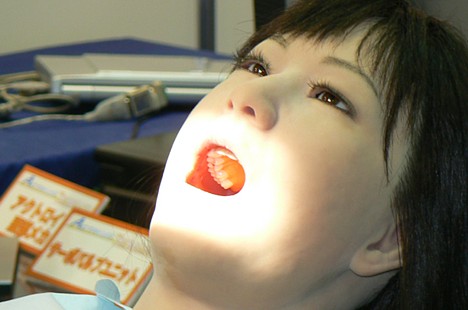
 The LEGO Group
The LEGO Group Fujitsu
Fujitsu Tsumura & Co.
Tsumura & Co. FAIN-Biomedical Inc.
FAIN-Biomedical Inc. Komatsu Ltd.
Komatsu Ltd.